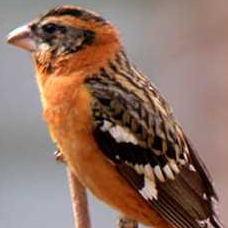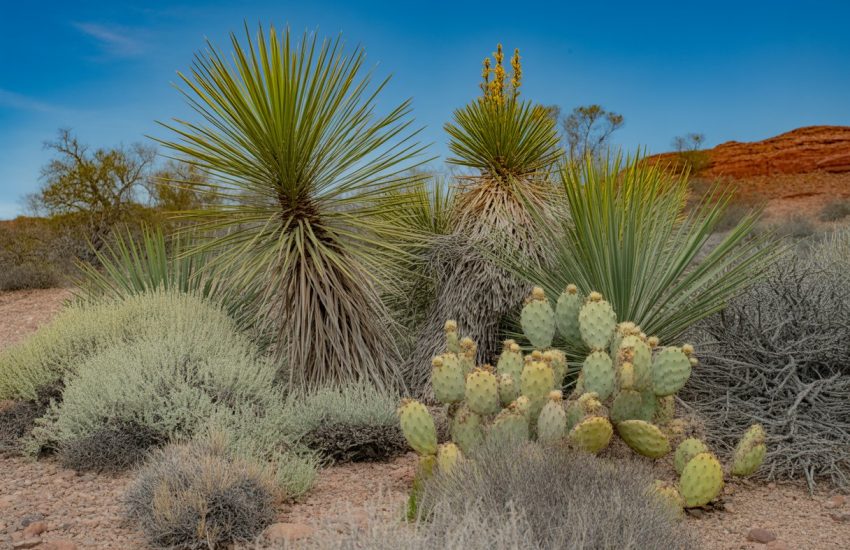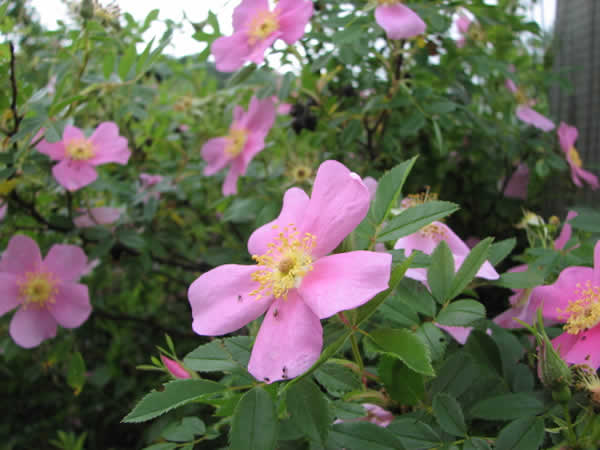Native Plant List – Alaska

This is a "starter" list of native plants for Alaska. It is intended for residential or commercial landscapers who want to create attractive and varied native landscapes.
Alaska Trees
| Common Name | Scientific Name | Sun | Moisture | Height | Comments |
|---|---|---|---|---|---|
| Paper Birch | Betula papyrifera | F | A | 50-70' | White, peeling bark. Nice fall color. |
| Alaska Cedar | Chamaecyparis nootkatensis | P-F | W | 25-100' | White bark, weeping branches, evergreen foliage. |
| American Larch | Larix laricina | F | W | 50-70' | Deciduous. Inconspicuous. Rapid growth. |
| White Spruce | Picea glauca | P-F | A | 50-100' | Evergreen. White-green needles. Food for wildlife. |
| Black Spruce | Picea mariana | F-P | W | 40-80' | Evergreen. Blue-green needles. Low branches take root. |
| Sitka Spruce | Picea sitkensis | P-F | W | 40-150' | Yellow bloom in May. Evergreen. |
| Beach Pine | Pinus contorta | F | D | 20-30' | Evergreen. Dark-green needles, red-brown bark. |
| Balsam Poplar | Populus balsamnifera | F | W | 60-80' | Deciduous. Cottony seeds. Fragrant, resinous buds. |
| Quaking Aspen | Populus tremuloides | F | A | 35-50' | Deciduous. Nice fall color. Leaves tremble in breeze. |
| Western Hemlock | Tsuga heterophylla | P-S | A | 40-150' | Slow growing evergreen. Red-brown scaly bark. |
| Mountain Hemlock | Tsuga mertensiana | P-S | W | 30-100 | Delicate, evergreen foliage. Provides habitat for birds. |
Alaska Shrubs
| Common Name | Scientific Name | Sun | Moisture | Height | Comments |
|---|---|---|---|---|---|
| Green Alder | Alnus crispa | F | W | 10' | Thicket-forming, deciduous, produces cones & samaras. |
| Sitka Alder | Alnus sinuata | F | W | 10' | Fast-growing, fixes nitrogen, extensive root system. |
| Serviceberry | Amelanchier alnifolia | P-F | A | 15' | White flowers; small, edible purple berries. |
| Silverberry | Elaeagnus commutata | F | D-A | 12' | Silvery, ornamental foliage. |
| Common Mountain Juniper | Juniperus communis | F | W | 3' | Evergreen. Tolerates poor soil. Berry-like cones. |
| Labrador Tea | Ledum palustre | P-F | W | 3-4' | Aromatic leaves, fragrant white flower clusters. |
| Shrubby Cinquefoil | Potentilla fruticosa | F | A | 4' | Dark green leaves; yellow, buttercup-like flowers. |
| Prickly Rose | Rosa acicularis | P-S | D-A | 10' | Pink flowers, attractive, needs careful pruning. |
| Nutka Rose | Rosa nutkana | P-S | W | 4' | Edible, often very fragrant, pink flowers. |
| Thimbleberry | Rubus parviflorus | P-F | W | 6' | White-ish flowers, thimble-shaped fruit, good for wildlife. |
| Soapberry | Shepherdia canadensis | P | A | 4-20' | Edible, bitter red berries. |
| Mountain Ash | Sorbus sitchensis | P-F | D-A | 2-5' | Foliage colorful in autumn. Round, reddish berries. |
| Snowberry | Symphoricarpos albus | S | W | 3-5' | White berries. Tolerant of a variety of soils. |
| Alaskan Blueberry | Vaccinium alaskaense | P | W | 2-8" | Deciduous, berry-producing shrub. |
| Lingonberry | Vaccinium vitis-idaea | P | A | 3' | Evergreen. Edible red fruit. |
Alaska Flowering Perennials
| Common Name | Scientific Name | Sun | Moisture | Height | Comments |
|---|---|---|---|---|---|
| Northern Monkshood | Aconitum delphinifolium | P-F | W-A | 10-30" | Blue, sometimes white. Toxic: touch can cause numbness. |
| Cut-leaf Anemone | Anemone multifida | P | D | 12-18" | Fine, light-green leaves. Pink to maroon flowers. |
| Narcissis-flower Anemone | Anemone narcissiflora | F | A | 8-14" | White flowers with yellow centers. |
| Western Columbine | Aquilegia formosa | S-P | D-W | 2-3' | Delicate red flowers with yellow sepals. |
| Sea Pink | Armeria maritima | F | D | 8-10" | Dense tufts of grass-like leaves. White to pink flowers. |
| Arnica | Arnica spp. | F | D | 6-18" | Yellow flowers have medicinal value. |
| Aster | Aster spp. | F | A | 12-30" | Lavender to purple flowers. |
| Marsh Marigold | Caltha leptosepala | P-F | W | 1' | Heart-shaped waxy leaves. White saucer-shaped flowers. |
| Harebell | Campanula rotundifolia | P | A-D | 4-15" | Blue-violet. Attractive to wildlife. |
| Indian Paintbrush | Castilleja caudata | F | D-W | 8-12" | Pale yellow paintbrush-shaped flowers. |
| Arctic Daisy | Chrysanthemum arcticum | F | W | 14" | Can take salty soils. |
| Larkspur | Delphinium glaucum | P-F | W | 4-6' | Purple. Often found in wetlands. |
| Shooting Stars | Dodecatheon frigidum | F | A-W | 6-18" | Magenta to lavender. leafless stem. |
| White Fireweed | Epilobium angustifolium | F | A | 3-8' | Pink, showy flowers. Thrives in burned areas. |
| Dwarf Fireweed | Epilobium latifolium | F | W | 2' | Spikes of small magenta or pink flowers. |
| Northern Geranium | Geranium erianthum | P-F | A | 14-24" | Blue to violet. Attracts bees, butterflies, birds. |
| Wildflag Iris | Iris setosa | P-F | W | 12-24" | Deep violet blue flowers with long green leaves. |
| Nootka Lupine | Lupinus nootkatensis | F | D | 2-3' | Brilliant blue/purple flowers. Self-seeding. Seeds toxic. |
| Bluebells | Mertensia paniculata | Pink/blue/white bell-shaped drooping flowers. | |||
| Monkeyflower | Mimulus guttatus | F-P | W-A | 2-3' | Yellow flowers. Grows well along streams. |
| Field Oxytrope | Oxytropis campestris | F | D | 4-12" | Usually cream colored. Prefers rocky/gravelly slopes. |
| Yellow Oxytrope | Oxytropis maydelliana | F | D | 6-12" | Clusters of small, yellow flowers. |
| Jacob's Ladder | Polemonium acutiflorum | P-F | W | 3-6" | Mainly blue flowers. Leaves alternate sides like ladder. |
| Yellow Sedum | Sedum sp. | Yellow blooms. Good ground cover. Drought tolerant. | |||
| Beach Fleabane | Senecio pseudoarnica | F | A-W | 1-2' | Bright yellow. Coastal flower, withstands salt spray. |
| Northern Goldenrod | Solidago multiradiata | P-F | A-D | 1-2' | Grows in clusters of yellow flowers, elliptical leaves. |
| Violet | Viola spp. | S | W | 4-12" | Delicate purple flowers. Attracts butterflies. |
Alaska Perennial Ferns
| Common Name | Scientific Name | Sun | Moisture | Height | Comments |
|---|---|---|---|---|---|
| Lady Fern | Athyrium filix-femina | F-S | W-D | 2-3' | Light green, lacy leaves. |
Alaska Grasses & Grass-like
| Common Name | Scientific Name | Sun | Moisture | Height | Comments |
|---|---|---|---|---|---|
| Bluejoint Grass | Calamagrostis canadensis | F | W | 3-5' | Tussock-forming with light-colored seeds. |
| Tufted Hairgrass | Deschampsia caespitosa | F | W | 2-3' | Clump-forming. Semi-evergreen. |
| Vanilla Grass | Hierochloe odorata | F | W | 1-2' | Fragrant, good soil stabilizer. Spreads quickly. |
| Alpine Bluegrass | Poa alpina | F-P | D | 2' | Densely tufted. Thick, fleshy leaves. |
| Sun Exposure | Soil Moisture | Drought Tolerance |
|---|---|---|
| F = Full Sun | W = Wet | E = Excellent |
| P = Part Sun | A = Average | G = Good |
| S = Shade | D = Dry | M = Moderate |
| P = Poor |


